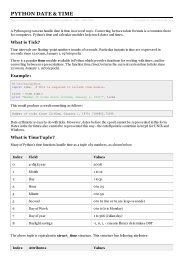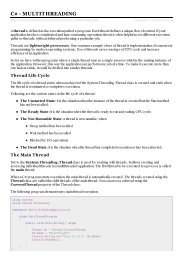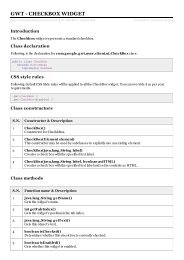Download Operating System Tutorial (PDF Version) - Tutorials Point
Download Operating System Tutorial (PDF Version) - Tutorials Point
Download Operating System Tutorial (PDF Version) - Tutorials Point
You also want an ePaper? Increase the reach of your titles
YUMPU automatically turns print PDFs into web optimized ePapers that Google loves.
CHAPTER<br />
12<br />
I/O Software<br />
This section describes interrupts, application I/O interface, Kernel Subsystem and device<br />
driver.<br />
Interrupts<br />
The CPU hardware uses an interrupt request line wire which helps CPU to sense after<br />
executing every instruction. When the CPU checks that a controller has put a signal on the<br />
interrupt request line, the CPU saves a state, such as the current value of the instruction pointer,<br />
and jumps to the interrupt handler routine at a fixed address. The interrupt handler part<br />
determines the cause of the interrupt performs the necessary processing and executes an<br />
interrupt instruction to return the CPU to its execution state.<br />
The basic mechanism of interrupt enables the CPU to respond to an asynchronous event, such<br />
as when a device controller becomes ready for service. Most CPUs have two interrupt request<br />
lines.<br />
<br />
<br />
non-maskable interrupt - Such kind of interrupts are reserved for events like<br />
unrecoverable memory errors.<br />
maskable interrupt - Such interrupts can be switched off by the CPU before the<br />
execution of critical instructions that must not be interrupted.<br />
The interrupt mechanism accepts an address - a number that selects a specific interrupt<br />
handling routine/function from a small set. In most architecture, this address is an offset stored in<br />
a table called the interrupt vector table. This vector contains the memory addresses of<br />
specialized interrupt handlers.<br />
TUTORIALS POINT<br />
Simply Easy Learning Page 70
















